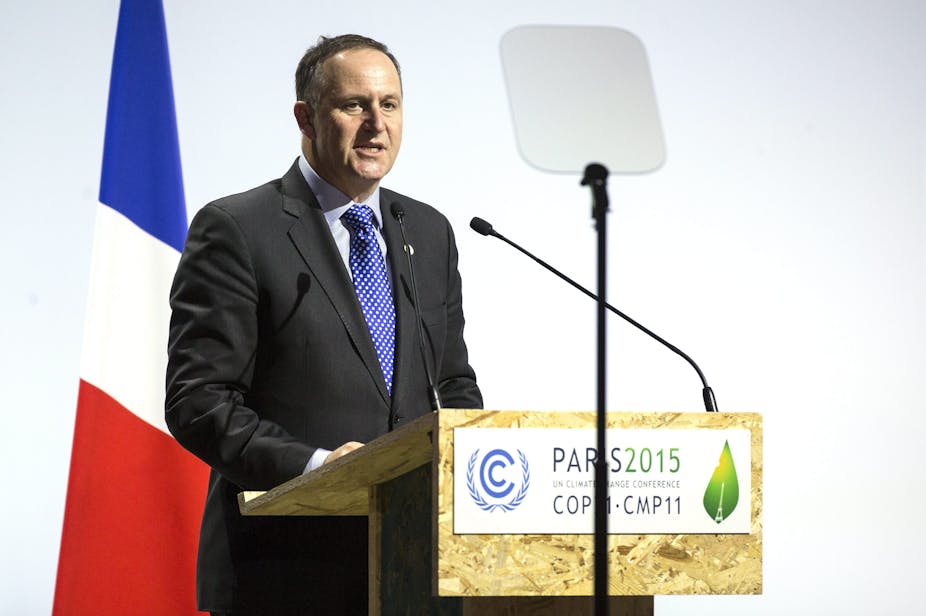New Zealand had a fairly high profile on day 1 of the COP21 in Paris. Prime Minister John Key told the opening Leaders Session of his intent to make a “strong contribution” through a new emissions-reduction target of 30% below 2005 levels by 2030.
He failed to clarify, however, that this is in fact a weaker target than the previous 5% reduction below 1990 levels by 2020, for two reasons:
That target was unconditional, whereas the new one is conditional on the future rules of carbon markets and forest sinks that are yet to be determined at the COP (or more probably in the years to follow)
-
The new target equates to 11.2% below 1990 levels by 2030. Whereas this is a greater reduction of greenhouse gases, we have 10 more years to get there. So the annual rate of reductions of around 3 million tonnes per year to meet the old target has dropped to 1.3 Mt per year with the new one. What’s more, there are no policies yet in place as to how to reduce CO₂ emissions other than the emissions trading scheme that has not yet delivered on reductions as projected and is currently under review – with agricultural emissions already excluded.
Key’s announcement of NZ$50 million a year for 4 years for “climate-related support” mainly for Pacific nations to move towards clean energy is a good step. It may also help to alleviate the environmental refugees who will no doubt be heading towards New Zealand in the future – perhaps around the time that sea level rise will also be creating domestic refugees from the roughly 10,000 New Zealand homes recently identified as being at risk by the Parliamentary Commissioner for the Environment.
An extra NZ$5 million a year for 4 years on agricultural emissions-reduction research was also positive, though given we have one of the lowest R&D investments per unit of GDP in all OECD countries, New Zealand should be doing more anyway.
The Prime Minister was also a leading figure at the press conference for the “Friends of Fossil Fuel Subsidy Reform” that New Zealand was involved in establishing some years ago. It now has around 40 nations involved. A communiqué was presented to the UNFCCC Secretary, Christiana Figueres, that provides good arguments for countries to be encouraged to remove the half-trillion dollars in annual global fossil fuel subsidies if we are to make the transition to a low-carbon economy.
Such policy changes could make a major contribution to total emissions reductions, an argument originally put forward by the International Energy Agency several years ago and now with greater evidence to back it.
In New Zealand, around three years ago Peter Hardstaff of the WWF New Zealand branch reported that New Zealand’s subsidies to the industry totalled around NZ$70 million a year, although a recent APEC review showed they are now near zero. It depends how they are measured and what is included.
For example, in the recent round of government science funding, under the category “Energy and minerals”, two projects received around NZ$14 million and both were related to oil and gas exploration. So is that a subsidy to fossil fuels, or not?
For this reason, New Zealand (alongside Belgium) was named one of the “Fossils of the Day” on day 1 of the conference, as the Climate Action Network pointed out that despite removing subsidies for fossil fuel consumption, New Zealand still supplies NZ$80 million in fossil energy production subsidies.
Incidentally, no projects relating to reducing fossil fuel demand (such as public transport initiatives, energy effienciency, or renewable energy for heating) received a single research dollar in the latest funding round.
So how is New Zealand ever going to meet its new emissions target, inadequate as it is, if we are not prepared to fund the necessary research needed to aid the transition. Will we really have to rely on buying carbon credits (and if so, from whom and for how much) and planting more forests?

